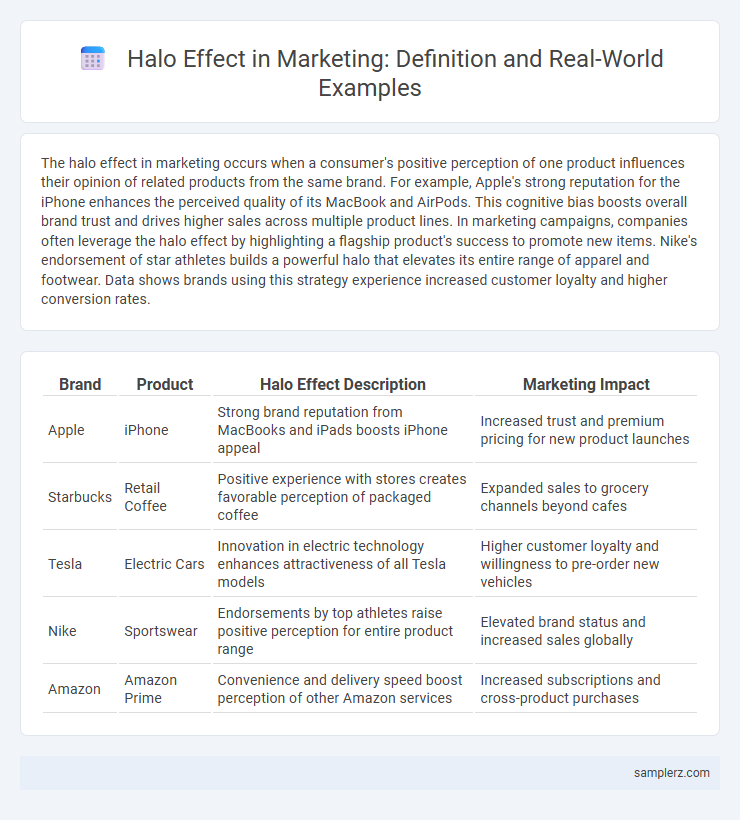The halo effect in marketing occurs when a consumer's positive perception of one product influences their opinion of related products from the same brand. For example, Apple's strong reputation for the iPhone enhances the perceived quality of its MacBook and AirPods. This cognitive bias boosts overall brand trust and drives higher sales across multiple product lines. In marketing campaigns, companies often leverage the halo effect by highlighting a flagship product's success to promote new items. Nike's endorsement of star athletes builds a powerful halo that elevates its entire range of apparel and footwear. Data shows brands using this strategy experience increased customer loyalty and higher conversion rates.
Table of Comparison
| Brand | Product | Halo Effect Description | Marketing Impact |
|---|---|---|---|
| Apple | iPhone | Strong brand reputation from MacBooks and iPads boosts iPhone appeal | Increased trust and premium pricing for new product launches |
| Starbucks | Retail Coffee | Positive experience with stores creates favorable perception of packaged coffee | Expanded sales to grocery channels beyond cafes |
| Tesla | Electric Cars | Innovation in electric technology enhances attractiveness of all Tesla models | Higher customer loyalty and willingness to pre-order new vehicles |
| Nike | Sportswear | Endorsements by top athletes raise positive perception for entire product range | Elevated brand status and increased sales globally |
| Amazon | Amazon Prime | Convenience and delivery speed boost perception of other Amazon services | Increased subscriptions and cross-product purchases |
Understanding the Halo Effect in Marketing
The halo effect in marketing occurs when consumers' positive perception of a flagship product influences their overall opinion of the brand, leading to increased trust and purchase intent across the product line. For example, Apple's reputation for innovative design and high-quality iPhones boosts consumer confidence in its other products like MacBooks and AirPods. This cognitive bias allows marketers to leverage star products to elevate entire brand portfolios, driving higher sales and stronger brand loyalty.
Classic Halo Effect Examples in Branding
Apple's iconic logo enhances the perceived quality of all its products, creating a powerful halo effect that influences consumer trust and loyalty. Nike's association with elite athletes transfers an image of performance and excellence to its entire product line, boosting brand desirability. Coca-Cola's consistent branding and positive emotional associations extend to new product launches, leveraging the classic halo effect to drive market acceptance and customer preference.
Celebrity Endorsements Leveraging Halo Effect
Celebrity endorsements leverage the halo effect by associating a well-known personality's positive attributes, such as trustworthiness and appeal, with a brand, enhancing consumer perception and driving sales. For example, Nike's collaboration with Michael Jordan boosted the brand's credibility and desirability by capitalizing on Jordan's athletic excellence and popularity. This strategic use of celebrity endorsement creates an implicit transfer of goodwill, increasing brand loyalty and market influence.
Product Line Extensions and the Halo Effect
Product line extensions benefit from the halo effect by leveraging the positive reputation of a flagship product to boost consumer perception and sales of new, related products. For example, Apple's success with the iPhone creates a halo effect that enhances the market acceptance of its accessories, such as AirPods and Apple Watch. This strategy increases brand loyalty and facilitates easier market entry for expanded offerings within the same product category.
Packaging Design: Creating a Positive First Impression
Packaging design significantly influences consumer perception, often creating a halo effect that extends to the entire brand experience. A premium, well-designed package can lead consumers to assume higher product quality and reliability, boosting brand trust and purchase intent. For example, Apple's sleek packaging conveys innovation and sophistication, positively impacting how customers view all Apple products.
Customer Reviews Amplifying the Halo Effect
Customer reviews significantly amplify the halo effect by enhancing brand perception through positive customer experiences shared online. High ratings and glowing testimonials create a cognitive bias where potential buyers associate overall product quality with specific praised features. This influence drives increased trust, higher conversion rates, and stronger brand loyalty in competitive markets.
Retail Store Atmosphere and Halo Effect Influence
A retail store with a clean, well-organized layout and appealing lighting creates a positive halo effect that enhances customers' perception of product quality and customer service. This favorable atmosphere leads shoppers to assume higher value and trustworthiness in merchandise, increasing purchase likelihood. Evidence shows that improved store ambiance can boost sales by up to 20%, leveraging the halo effect to influence consumer behavior subconsciously.
Digital Advertising and Visual Halo Effects
Digital advertising leverages the halo effect by using visually appealing and high-quality graphics to enhance brand perception, influencing consumers to associate positive attributes with the entire product line. Eye-catching imagery and consistent color schemes create visual halo effects that increase brand trust and recall, driving higher engagement rates on social media platforms. Brands like Apple and Nike utilize sleek digital ads to transfer the premium appeal of flagship products onto newer or less popular offerings, boosting overall sales.
Corporate Social Responsibility Enhancing Brand Image
Corporate Social Responsibility (CSR) initiatives create a halo effect by associating brands with positive social values, which enhances overall brand image and consumer trust. Companies like Patagonia leverage their environmental commitments to boost customer loyalty and justify premium pricing. This strategic alignment between ethical practices and marketing amplifies perceived brand quality beyond product features alone.
The Role of Influencer Marketing in Halo Effect
Influencer marketing exemplifies the halo effect by leveraging the positive traits of popular social media personalities to enhance the perceived value of a brand or product. When consumers admire an influencer's credibility, trustworthiness, or style, those attributes transfer to the endorsed merchandise, boosting brand awareness and sales. Companies investing in influencer partnerships often experience increased customer loyalty and higher conversion rates due to this psychological association.

example of halo effect in marketing Infographic
 samplerz.com
samplerz.com